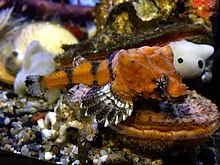Bothragonus
| Bothragonus | |
|---|---|

| |
| A rockhead on top of a rock scallop at the Oregon Coast Aquarium | |
| Scientific classification | |
| Domain: | Eukaryota |
| Kingdom: | Animalia |
| Phylum: | Chordata |
| Class: | Actinopterygii |
| Order: | Perciformes |
| Family: | Agonidae |
| Subfamily: | Bothragoninae Lindberg, 1971[1] |
| Genus: | Bothragonus T. N. Gill, 1883 |
| Type species | |
| Hypsagonus swanii Steindachner, 1876[2] | |
Bothragonus is a genus of marine ray-finned fishes belonging to the family Agonidae, the poachers and related fishes. It is the only genus in monotypic subfamily Bothragoninae. These fishes are found in the northern Pacific Ocean.
Taxonomy
Bothragonus was first proposed as a genus by the American zoologist Theodore Gill in 1883 with Hypsagonus swanii, which had been described in 1876 by Franz Steindachner from Port Townsend on Puget Sound in Washington, as its type species.[2][3] In 1971 the Soviet ichthyologist Georgii Ustinovich Lindberg proposed that the genus Bothragonus be placed in the new subfamily of the Agonidae, the Bothragoninae, although this was not universally accepted.[4] The 5th edition of Fishes of the World recognises the validity of the Bothragoninae as a subfamily of the Agonidae.[5]
Species
There are currently two recognized species in this genus:[6]
- Bothragonus occidentalis Lindberg, 1935
- Bothragonus swanii (Steindachner, 1876) (Rockhead)
Etymology
Bothragonus is a combination of bothra, meaning "cavity", a reference to the deep pit on the nape, and Agonus the type genus of the Agonidae.[7] 2
Characteritics
Bothragonus is characterised by the head and the front part of the body having a rhomboid cross section with the rear part of the body being laterally compressed. The first dorsal fin and the anal fin are poorly developed. There is a row of bony plates located between the upper and main lateral lines and another row is located between the two lower lateral lines. There is an enlarged, spineless plate on the snout and the lower side of the head is armoured with a number of sharply spined plates. The sensory canal on the occipital is broken at its middle. The urohyal has no pelvic keel, there is a postpelvic spine and two epurals.[4] These fishes have a maximum published total length of 8.9 cm (3.5 in).[6]
Distribution and habitat
Bothragonus are found in the eastern and western North Pacific Ocean.[4] They are found in shallow waters of less than 100 m (330 ft) depth and may be found in tidal pools.[8]
References
- ^ Richard van der Laan; William N. Eschmeyer & Ronald Fricke (2014). "Family-group names of Recent fishes". Zootaxa. 3882 (2): 001–230. doi:10.11646/zootaxa.3882.1.1. PMID 25543675.
- ^ a b Eschmeyer, William N.; Fricke, Ron & van der Laan, Richard (eds.). "Genera in the family Bothragoninae". Catalog of Fishes. California Academy of Sciences. Retrieved 2 January 2023.
- ^ Eschmeyer, William N.; Fricke, Ron & van der Laan, Richard (eds.). "Species in the genus Bothragonus". Catalog of Fishes. California Academy of Sciences. Retrieved 2 January 2023.
- ^ a b c Sheiko, B. A. and C. W. Mecklenburg (2004). "Family Agonidae Swainson 1839 — poachers" (PDF). California Academy of Sciences Annotated Checklists of Fishes. 30.
- ^ J. S. Nelson; T. C. Grande; M. V. H. Wilson (2016). Fishes of the World (5th ed.). Wiley. pp. 467–495. ISBN 978-1-118-34233-6. Archived from the original on 2019-04-08. Retrieved 2023-01-02.
- ^ a b Froese, Rainer; Pauly, Daniel (eds.). "Species in genus Bothragonus". FishBase. December 2012 version.
- ^ Christopher Scharpf & Kenneth J. Lazara, eds. (22 October 2022). "Order Perciformes: Suborder Cottoidea: Infraorder Cottales: Families Trichodontidae, Jordaniidae, Rhamphocottidae, Scorpaenichthyidae and Agonidae". The ETYFish Project Fish Name Etymology Database. Christopher Scharpf and Kenneth J. Lazara. Retrieved 2 January 2023.
- ^ Froese, Rainer; Pauly, Daniel (eds.). "Bothragonus swanii". FishBase. August 2022 version.
